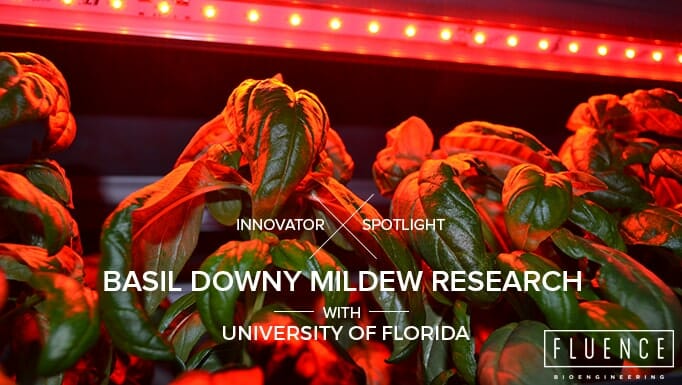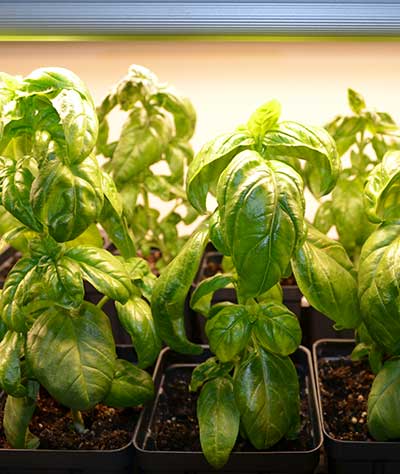
06 Apr Innovator Spotlight: University of Florida Institute of Food and Agricultural Sciences
Combating Basil Downy Mildew with Fluence Horticulture Lighting System
Basil grown in more than forty U.S. states and a number of additional countries has been plagued by a devastating foliar disease called downy mildew. In the United States, basil downy mildew (BDM) was first discovered in south Florida in 2007.
Basil’s popularity in home and restaurant kitchens alike has made it an important greenhouse crop for many farmers, but the causal organism of basil downy mildew produced massive spores on leaf surfaces and yellowing of the affected leaves that render the product unacceptable for the marketplace.
A few fungicides are available for treating the debilitating disease, but many growers are working hard to reduce their dependence on chemical treatments — and for organic farmers, they simply aren’t an option.
Researchers at the University of Florida (UF) Institute of Food and Agricultural Sciences (IFAS) — supported by a U.S. Department of Agriculture/National Institute of Food and Agriculture Specialty Crop Research Initiative Project (2011-2015) led by Rutgers University with collaboration from Cornell University — turned instead to red light as a method of containing BDM. With expertise in developing purpose-based spectra and photosynthetic photon flux density (PPFD), Fluence Bioengineering scientists developed an LED-based lighting system that emits 625nm red light at an average PPFD of 12 µmol/m2/s at 4’ mounting height.
University of Florida plant pathology associate professor Shouan Zhang and his postdoctoral associate Jaimin Patel designed the experiments and infected two sets of basil plants with the causal organism of downy mildew in the greenhouse. They allowed one set of plants to remain in the dark for 12 hours at night each day followed by its usual daily dose of full-spectrum day light, while another set of plants was placed under the special Fluence lighting system that emits 625nm red light.
“We are always looking for better ways to advance the agriculture industry,” said Zhang. “We are excited about the results and implications light-based plant disease treatment can bring for the future of organic crop production.”

Healthy basil under Fluence LED grow lights.
The hypothesis posed by the Fluence and UF scientists proved accurate. Six days after inoculation, BDM appeared on the plants placed in the dark, while no symptoms showed up on the plants that were treated with the 625nm red light. A second test returned similar results.
Fluence Horticulture Scientist Dr. Tharindu Weeraratne is working to understand the mechanisms behind why the red light suppresses the disease, but for now, the results are clear, and the scientific community is intrigued by this potentially crop-saving tool.
We believe that this could be a useful component in an integrated management program,” says Zhang.
“While advancement in scientific research and furthering our understanding of crop production is exciting, it’s seeing real-world benefits such as the results we’ve garnered from this study that reinforce the necessity of new ideas, new technology and new ways of thinking about solutions to problems.”
Farmers whose crops have been plagued by this devastating disease are also, of course, very interested in the promise held by the red light treatment provided by Fluence. As supplemental greenhouse lighting, this lighting system from Fluence could save agricultural enterprises on the brink of disaster from the devastation brought by basil downy mildew — organically and without the worry of harmful chemicals.
Fluence remains dedicated to working closely with commercial and academic agriculture institutions to allow them to continue their studies of this — and many more — revolutionary crop treatments.


